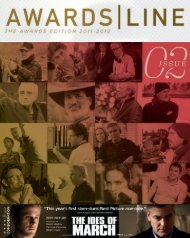MOVIE/ MINISERIES & REALITY ISSUE
MOVIE/ MINISERIES & REALITY ISSUE
MOVIE/ MINISERIES & REALITY ISSUE
Create successful ePaper yourself
Turn your PDF publications into a flip-book with our unique Google optimized e-Paper software.
CablePicks UpSlackTitanicNetworkLongformWanes,Jeanne Tripplehorn in FiveBy Ray RichmondJust when everyone assumed that the original televisionminiseries was either dead or restricted to beingthe loss-leader indulgence of HBO, up pops History’sHatfields & McCoys in May to show the worldthat if you make a three-night event on a compellingsubject with big stars (Kevin Costner, BillPaxton) and a quality pedigree, the masses will stillflock. Hatfields averaged nearly 14 million total viewersnightly, building to 14.3 million for Part 3 to becomethe most-watched entertainment telecast of all time onad-supported cable.Despite the success of Hatfields, so few miniseries arebeing done that the TV Academy last year was obligedto merge TV-movie and miniseries into a single category.There simply is no longer close to the number ofambitious, big-budget projects as were commissionedin the days of Roots (1977), Jesus of Nazareth (1977), TheWinds of War (1983) and War and Remembrance (1988-89). When it happens now, it’s generally on HBO viathe likes of Angels in America (2003), John Adams (2008),The Pacific (2010) and Mildred Pierce (2011). Yet evenHBO’s once-abundant longform output has slowed inrecent years just to a few projects annually.Blame the shifting economics of the TV business. “Thenetwork TV-movie model fell by the wayside,” explainsMichael Edelstein, president of international televisionproduction for NBCU, which acquired Carnival Filmsin 2008. “In terms of bang for your buck, marketinga TV movie is a tough business to be in. As the audiencehas acquired more and more choices, broadcastersneed to spend their marketing dollars more wisely,and that generally isn’t for one-off movies that go awayafter you air them. It’s for series.”The thing is, few areas of primetimetelevision have changedmore in the last 20 years thanthe longform business. Therewas a time in the 1980s when thethree major broadcast networkscommissioned 100 made-for-TV movies apiece, along with ahandful of long-running, expensiveminiseries. Now, broadcasters barely air muchmore than a handful between them. It’s fallen almostentirely to cable and PBS to pick up whatever slackthere is to pick up.Nonetheless, plenty of miniseries and movies still getproduced, many of which involve creative/partnershipfinancing that mirror independent film financing morethan a traditional TV deal. For instance, Carnival wasinvolved in producing the Emmy contender PageEight that aired last year as part of Masterpiece (whichco-produced) on PBS. The BBC provided the primaryfunding, but the risk was shared.Masterpiece is a minority financer of bigger productionslike Downton Abbey and Page Eight. And thereare factors that make producing period miniseries inparticular cheaper in the U.K., emphasizes Masterpieceexecutive producer Rebecca Eaton. “There are taxcredits and benefits from beingan independent company. Thework rules are slightly differentover there. But in large part,we’re in the business of attractingunderwriters and selling DVDs.”In the United States, however,most networks would rather puttheir programming resources intoseries that can pay off in repeatviewings than something with such limited shelf life asa mini or made-for-TV movie. The production costscan’t be amortized the same way, and there’s seeminglyless incentive to pull off the necessary creative financing.Rachel Weisz and Bill Nighy in Page EightTypical of how miniseries get made in the U.K. is theway that Britain’s ITV commissioned the four-hourmini Titanic that aired on ABC in April and waswritten by Downton Abbey scribe Julian Fellowes. Aco-production between the U.K. and Canada, it wasthe kind of ambitious project that requires multiplepartners to pull off financially, explains ITV’s head ofdistribution Maria Kyriacou.“We had 12 partners when Titanic was greenlit,”Kyriacou notes. “That means 12 broadcasters committedmoney on a prebuy that accorded them broadcastrights in their territory. By the time it aired, we’dplaced it in 100 territories. But when you’re setting upa big global miniseries event like this, it means presellingbased on a script. So people had to believe in theconcept and the talent attached to it.”Only a handful of big-budget miniseries are beingproduced worldwide in the English language each year,says Titanic exec producer Simon Vaughan. “Whatyou no longer have is a middle market,” he emphasizes.“Five years ago, you could make a $10 million miniseries.Now it’s pretty foolhardy to think you’re going tobe able to successfully produce and distribute anythingat that level. They all need to be $15 million-plus now.It’s almost not a business. It’s more of an indulgence.In general, a U.K./U.S. partnership with a significantEuropean presale is the best way to go.”Where the made-for-TV movie business continues tothrive as in the days of old is at the Hallmark Channel andLifetime, neither of which appears to have received thememo that this is a threadbare genre. Hallmark Channelhas 28 original movies and its sister, Hallmark MovieChannel, an additional eight originals in 2012 alone,while Lifetime has a slate of 56 original films across itstwo networks (also including Lifetime Movie Network).Hallmark has been able to create franchises with itsfilms such as The Good Witch starring Catherine Belland a series of movies based on Janette Oke novels.They keep costs low on production and monetize theproperties in a multitude of ways, including streamingweb content, electronic sell-through, social media platformsand repeated airings.“The durability and repeatability of our movie contentis very high,” stresses Michelle Vicary, Hallmark’s executiveVP of programming. “This isn’t a single-airingbusiness for us. They’re really more like evergreens.”Jennifer Morrison in FiveRob Sharenow, Lifetime’s executive VP of programming,also points to the repeatability factor as a reasonwhy the volume movie of the week business makessense for his networks. Lifetime’s originals generallydraw a bigger number than big-budget studio acquisitions.One recent example was the much-praised 2011breast cancer film anthology Five that the network isgiving a sizable push for Emmy attention this year.“We’re also able to use our film library in a significantway, owning them and releasing them on DVD,”Sharenow says. “International is also an excitinggrowth area for us. There’s a big appetite for using theU.S. as a foreign sales partner … The classic Lifetimetrue-crime films do very well on the overseas market.You have the core element of women betrayed, andthat human drama exports surprisingly well. There’ssomething primal about the storytelling.”Moreover, there remains a huge growth opportunity inmaking the kind of films the theatrical studios no longerare interested in, Sharenow believes. “We’re talkingabout telling great stories that grown-ups are interestedin. Our mentality isn’t, ‘How many young men canwe get in the theater opening weekend?’ It’s seizingthe opportunity to attract great scripts, actresses anddirectors who want to do serious projects. Who is goingto make the next Kramer vs. Kramer, the next Witness,the next The Big Chill going forward? Maybe we will.”30EMMY AWARDS PRINT EDITIONS 2012











